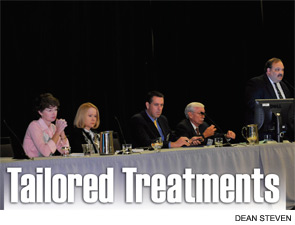
Explore This Issue
February 2011SCOTTSDALE—Otolaryngologists treating vocal fold paralysis have many options from which to choose, but the best choice depends on the wants and needs of the patient, a panel of experts said here at the Triological Society’s Combined Sections Meeting on Jan. 28.
The panelists discussed the fine points of vocal fold injection, medialization laryngoplasty, reinnervation of the vocal folds and arytenoid adduction. The panelists said that they don’t perform one procedure to the exclusion of the others, noting that sometimes a patient can have more than one good option, although certain kinds of situations can lend themselves more to one kind of procedure than another.
Vocal Fold Injection
Clark Rosen, MD, director of the University of Pittsburgh Voice Center in Pa., said vocal fold injection can augment the anterior two-thirds of the vocal fold and can be adjusted according to how much augmentation is wanted.
“Over the years, things have changed dramatically,” Dr. Rosen said. “We now have more and more access to new materials, most of them, in all honesty, for the cosmetic injectable world. The nice thing about these materials is now we have materials with different durations, and most of them can be used through a finer-gauge needle, which significantly facilitates in-office local anesthesia.”
But injections cannot close the posterior third of the vocal fold, cannot address a vocal fold that is too short, cannot medialize a lateralized vocal fold or, in most cases, provide a permanent fix, Dr. Rosen said. The effects of an injection can last from about two months to two years, although lipo injections are permanent.
Dr. Rosen said it is particularly beneficial to keep the patient awake during the procedure. “The ability to monitor vocal fold closure and voice quality with real-time feedback is quite helpful and important,” he said.
Medialization Laryngoplasty
Gaelyn Garrett, MD, medical director of the Vanderbilt Voice Center in Nashville, said she uses injections for temporary augmentation, medialization laryngoplasty for long-term and permanent improvements and arytenoid adduction to enhance fold positioning during medialization. Dr. Garrett said it is important, while performing medialization, to keep in mind the complex movement of the larynx.
“Anyone who does framework surgery really needs to appreciate the three-dimensional movement of the laryngeal structures,” she said. “This is not a two-dimensional organ, so you need to look at the movement of the cricoarytenoid joint.”
She said she prefers her patients to be “quite awake” during the procedure, for best results. “It is incredibly important to have visual and auditory feedback,” she said.
When placing the window for the procedure, “the idea is to keep that window as low as possible in the cartilage,” while keeping in mind the difference between a male larynx and a female larynx.
“We still do a lot of hand carving of our implants,” Dr. Garrett said. “The implant is fit to the patient, not the window.”
Reinnervation
Randy Paniello, MD, associate professor of otolaryngology-head and neck surgery at Washington University in St. Louis, Mo., said that, while reinnervation is done only in a minority of his vocal fold paralysis cases, it is an important and effective option to consider. “I use reinnervation in cases where I think it’s potentially going to give patients a better voice,” he said.
About 12 papers involving about 300 patients, have all concluded that the procedure works well, but there is still a lot of skepticism about reinnervation, Dr. Paniello said.
“I still hear people saying things like, ‘I heard it doesn’t work that well,’ things like that,” he said. “And I just don’t understand why they don’t accept the data that’s put before them.”
In a randomized trial of 24 patients at nine centers, Dr. Paniello compared reinnervation to medialization. Both procedures were found to have worked well.
In that study, which Dr. Paniello said is expected to be published later this year, researchers examined patient characteristics, such as gender and smoking history, to see whether one procedure worked better over the other in those groups. Age was the only factor that seemed to make a difference. “There was a natural break in the data at plus or minus age 52,” Dr. Paniello said.
Only the under-52 reinnervation group reached the “normal” range in voice as rated by untrained listeners. That group also reached the normal range in quality of life scores and had perfect scores on the GRBAS (grade, roughness, breathiness, aesthenia, strain) scale of roughness, breathiness and other voice qualities.
“Reinnervation should really be considered,” Dr. Paniello said, “especially for the younger patients.”
A major disadvantage of reinnervation is that it can take four to eight months to see results, which might make it a bad option for patients who need their voices back immediately for work or other reasons, he said.
Arytenoid Adduction
Gayle Woodson, MD, chair of otolaryngology at Southern Illinois University in Springfield, said arytenoid adduction, in which the arytenoid cartilage is rotated to medialize the vocal process, can be useful in patients with posterior glottic incompetence. It can be combined with a Type 1 thyroplasty for better results.
The reverse of this procedure, arytenoid abduction, is a “promising” treatment for bilateral laryngeal paralysis, she said.
Arytenoid adduction is frequently performed when there is an urgent need on the part of the patient, she said.
“There’s only a certain group of patients that it’s indicated in,” she said. “The patients that I’ve run into that need it the most are the ones that have a really incompetent larynx because their vocal fold is very lateral. A lot of times they have difficulty swallowing and really the need to get them swallowing is the urgent indication.”
Even if the need is less urgent, the procedure might be a good option. Certain patients might be able to get the best voice by getting the arytenoid position “right where you want it,” Dr. Woodson said.
Leave a Reply